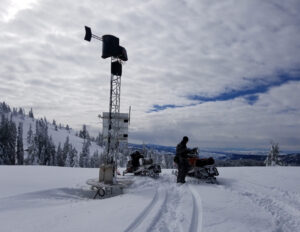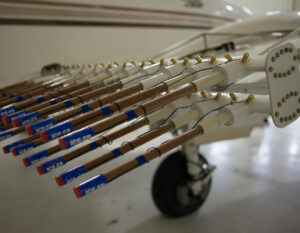The Idaho Water Resource Board (IWRB) is a state agency that was created in 1963 to protect Idaho’s water by formulating a comprehensive state water plan. One of its main projects in recent years has been the recharging of the Eastern Snake Plain aquifer (ESPA), which had been depleted by overuse and was no longer supplying enough water for all users. The IWRB has addressed this problem with an array of water conservation solutions and even the creation of new water through cloud seeding.
In this interview, IWRB Chairman Roger Chase tells Irrigation Leader about the IWRB’s history and its current efforts on the ESPA.
Irrigation Leader: Please tell us about your background and how you came to be in your current position.
Roger Chase: I’ve been involved in politics and water issues throughout my life. I served in the state legislature for three terms and was the mayor of one of the largest cities in the state, Pocatello, for a couple of terms. I was appointed to the board to represent the cities and recreationalists. I’m also a Democrat, which can be hard to find in Idaho. I’ve been on the board for around 12 years and I’ve chaired it for 8.
Irrigation Leader: Please tell us about the IWRB.
Roger Chase: The IWRB was founded in 1963, when the City of Los Angeles was looking at pumping water from Idaho to Southern California. One of Idaho’s great assets, even though the majority of the state is desert, is good water resources, and the board was formed, quite frankly, to protect Idaho’s water. In Idaho, as in any place, people are always asking how to use the water someplace else, which we try to stop.

Irrigation Leader: Is the IWRB a public entity?
Roger Chase: It is a state agency. We’re sworn in by the state, and we have to follow all the state rules for public organizations.
Irrigation Leader: Please tell us about the issue that the IWRB is trying to solve on the ESPA.
Roger Chase: The problem is that we are pumping and using more water from the aquifer than is going in. About 13 percent of the water going into the aquifer comes from snow and rain. Another 15–16 percent comes from tributaries and rivers that run across the aquifer. The remainder is water that we artificially put in. Almost 30 years ago, we got to the point at which we were taking more water out than we had water to put in. That’s when we moved forward with this project.
Irrigation Leader: Are the IWRB’s objectives on the aquifer as simple as putting more water in and taking less water out?
Roger Chase: You could say that. We still have enough water to make some changes before this becomes a crisis. The other thing that moved this forward is that Idaho has a law that works according to a principle common in the West called “First in time, first in line.” If my water right dates to January 1, and yours dates to January 2, then I get all my water before you get any of your water. It’s a harsh rule, but we were going to have to enforce it. It was forced on us by the courts, because some of the fish hatcheries in the Snake River system weren’t getting the water that they needed. The court ordered us to make them whole; it said we were not providing water to agricultural land properly, either. The court said we had to come up with an additional 400,000–500,000 acre-feet of water to meet these needs. We were required to make an estimate at the start of the year of how much water we would need and to report on it at the end of the year, and based on that, we would be told how much water we needed to come up with. We came close to shutting down 15–18 cities’ water supplies and the water to 400,000 acres of land, but we were finally able to get people to the table and to come up with a plan that would follow the first-in-time, first-in-line principle while also helping the pumpers and avoiding destroying the industry on the Snake River Plain, which represents about 25 percent of Idaho’s income. We also established a policy on the Snake River Plain that says that you cannot break new land unless you dry up some other land. That was pretty controversial, but it helped our plan succeed.
Irrigation Leader: What are some of the other methods you’ve used to mitigate the problem on the aquifer?
Roger Chase: First, we required pumpers to cut their water use by about 200,000 acre-feet a year. Then we estimated what would be necessary to hold the aquifer at a certain level, concluding that we needed to charge the aquifer by about 250,000–300,000 acre-feet a year. We’ve been successful in doing that. In addition, we meter everybody, from major pumpers to people who farm 20 acres of land.
Other key elements were the regulations to build structures to deliver the water to the desert where we needed it and the positive relations we have and continue to develop with other agencies. We probably couldn’t have gotten the permitting done with today’s rules, which are good rules. We worked out a deal with the existing canal companies to use their canals for recharging in the winter when they’re not delivering water. That saves us tens, if not hundreds, of millions of dollars. Without their support, we couldn’t have done this.
Irrigation Leader: Where does all the recharge water come from, and what are the main methods by which you are saving all this water?
Roger Chase: According to our plan, the state provides half the water needed to stabilize the aquifer, and the private sector provides the other half. We take advantage of any opportunity for efficiency we can find, even things as simple as taking the sprinklers off headlines. We tightened up the dates when farmers can start using irrigation water,
which sparked some conflict. Water users also had to come up with ideas of their own on how to save water. They’ve been pretty effective. We provide monetary incentives to encourage people to run water longer in the winter. We also pay a higher rate the longer you can retain that water. That’s important to us because we’re hoping that we get through 5‑ and 10‑year droughts with this recharge program.
One of the things that’s been really pleasing to us is that stream flows have increased. Many of the springs in our Thousand Springs region have come back.
Irrigation Leader: Would you tell us about your cloud seeding program?

Roger Chase: Cloud seeding has been a pleasant surprise. Idaho Power took the lead on it, and we invested in it. We now work with four or five universities, private organizations, and Idaho Power on it. The reason that Idaho Power is involved is that cloud seeding helps generate water for hydropower. As the result of court cases, agriculture gets its water before Idaho Power does.
Cloud seeding has been going on for 40–50 years. One of the problems with it is that it is hard to tell what’s happening high up in the clouds, so we took Doppler radar devices and put them up high as we could in the mountains. The information we get from them has allowed us to decide more precisely when to seed clouds, with the result that we are able to create nearly 300,000 acre-feet of water a year. When a cold front comes through, our planes will go through and spray their iodine mixture, and then 15–20 minutes later, it will start raining. We know it’s the rain from the cloud-seeding program because of the samples we collect in the field after the storms.
Irrigation Leader: Is that expensive?
Roger Chase: Last year we spend about $1.7 million on cloud seeding, and our partners, Idaho Power Company and the water users, contributed $2.5 million.
Irrigation Leader: Would you tell us about how you built the consensus necessary to make the IWRB’s aquifer programs a success?
Roger Chase: The biggest thing was the call made by the court. We were literally days away from shutting off massive amounts of water. The strange thing was that the organization that filed the suit was a fish hatchery; a fish hatchery hardly uses any water. But because aquifers rise like lakes, to get water to the spring, you had to get it up to a higher level. It probably helped that the court said we had to fix it and that the only way we could do that was either to shut off the water or to implement new ideas. Another big factor was that we finally had a board and a director who said we had to do something. I’d also like to mention a couple of people who really helped: the speaker of the Idaho House of Representatives, Scott Bedke; the governors; and the farmers themselves.
Irrigation Leader: Are you aware of other similar situations elsewhere in the country, and did you draw some inspiration from how they had dealt with those problems?
Roger Chase: I don’t think there were many people who were looking at recharge as a viable option. I remember sitting in board meetings in which people just laughed and said that we would never be able to recharge that much water. A lot of places don’t have the two things that you really need to make it work. One is excess water. Another is specific to our aquifer, which is a lava aquifer. It’s like concrete that’s been poured into the ground. There are big open cavities within it, which is why we refer to it as a lake. The aquifer could be rising for months as you fill it up, and then for 6 months, the water level might not move. That’s because the water has spilled over a ridge and is filling another empty space on the other side. In California, when they take water out of the aquifer, they have a big problem with the land collapsing to fill in that space. That didn’t happen here—we had a big open space where we could put water.
Irrigation Leader: What advice do you have for other water managers?
Roger Chase: I would advise everybody to do something. The first step is just to start doing stuff. Don’t be scared to try new things. There’s enough knowledge out there about recharging, so there are no excuses. The longer you wait, the harder it gets.
Build good contracts with the folks you’re working with. Once they buy in and see what you can do, you can get good funding from large irrigation districts.
We’re adjudicating the water in Idaho through a state and federal process to make sure that these waters stay in Idaho. That’s important—states like Idaho and Montana that still have a little excess water are always fearful about where our water is going to go. We don’t have a lot of political clout, but we’ve been proactive and we have put ourselves in a pretty good position.
Roger Chase is the chairman of the Idaho Water Resource Board. He can be contacted at idwrinfo@idwr.idaho.gov.
